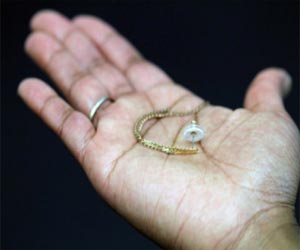- Home
- Editorial
- News
- Practice Guidelines
- Anesthesiology Guidelines
- Cancer Guidelines
- Cardiac Sciences Guidelines
- Critical Care Guidelines
- Dentistry Guidelines
- Dermatology Guidelines
- Diabetes and Endo Guidelines
- Diagnostics Guidelines
- ENT Guidelines
- Featured Practice Guidelines
- Gastroenterology Guidelines
- Geriatrics Guidelines
- Medicine Guidelines
- Nephrology Guidelines
- Neurosciences Guidelines
- Obs and Gynae Guidelines
- Ophthalmology Guidelines
- Orthopaedics Guidelines
- Paediatrics Guidelines
- Psychiatry Guidelines
- Pulmonology Guidelines
- Radiology Guidelines
- Surgery Guidelines
- Urology Guidelines
Contraceptive jewelry is the future of birth control,finds new study

USA: Birth control or contraception could now be possible by just putting on jewelry including earring, wristwatch, necklace or rings. A recent study published in the Journal of Controlled Release describes a novel technique of delivering contraceptive hormones that are contained in patches applies to portions of the jewelry in contact with the skin. This allows the drugs to be absorbed into the body. Although no human testing has been done on the matter, initial testing suggests that the contraceptive jewelry may deliver sufficient amounts of hormone to provide contraception.
Beyond contraceptives, the jewelry-based technique might also be used for delivering other drugs through the skin.
Lack of adherence to medication dosing schedules is a significant cause of morbidity and mortality with large associated financial costs. This is especially true for contraceptive hormones, which provide almost perfect prevention of pregnancy when used correctly but have significant failure rates in typical use, due largely to poor adherence.
Mark Prausnitz, a Regents Professor and the J. Erskine Love Jr. chair in the School of Chemical and Biomolecular Engineering at the Georgia Institute of Technology and colleagues introduced pharmaceutical jewelry, in which a transdermal patch is incorporated into jewelry worn on the skin to increase medication acceptability and adherence.
To demonstrate the approach, the authors incorporated transdermal patches containing the contraceptive hormone leveonorgestrel (LNG) into an earring, a ring, a necklace, and a wristwatch.
“The more contraceptive options that are available, the more likely it is that the needs of individual women can be met,” said Prausnitz. “Because putting on jewelry may already be part of a woman’s daily routine, this technique may facilitate compliance with the drug regimen. This technique could more effectively empower some women to prevent unintended pregnancies.”
Contraceptive jewelry adapts transdermal patch technology that is already used to administer drugs that prevent motion sickness, support smoking cessation, and control the symptoms of menopause, but have never been incorporated into jewelry before. Contraceptive patches are also already available, but Prausnitz believes pairing them with jewelry may prove attractive to some women – and allow more discreet use of the drug delivery technology.
“There is a lot of experience with making and using conventional transdermal patches,” he said. “We are taking this established technology, making the patch smaller and using jewelry to help apply it. We think that earring patches can expand the scope of transdermal patches to provide additional impact.”
The concept was tested on animal models, first on ears from pigs. Test patches mounted on earring backs and containing the hormone levonorgestrel were also applied to the skin of hairless rats. To simulate removal of the earrings during sleep, the researchers applied the patches for 16 hours, then removed them for eight hours. Testing suggested that even though levels dropped while the earrings were removed, the patch could produce necessary amounts of the hormone in the bloodstream.
The earring patch tested by the researchers consisted of three layers. One layer is impermeable and includes an adhesive to hold it onto an earring back, the underside of a wristwatch or the inside surface of a necklace or ring. A middle layer of the patch contains the contraceptive drug in solid form. The outer layer is a skin adhesive to help stick to skin so the hormone can be transferred. Once in the skin, the drug can move into the bloodstream and circulate through the body.
The researchers tested patches adhered to earring backs, about one square centimeter in area, and placed them tightly on the skin of the test animals. Earring backs and watches may be most useful for administering drugs because they remain in close contact with the skin to allow drug transfer. The dose delivered by a patch is generally proportional to the area of skin contact.
“The advantage of incorporating contraceptive hormone into a universal earring back is that it can be paired with many different earrings,” Prausnitz noted. “A woman could acquire these drug-loaded earring backs and then use them with various earrings she might want to wear.”
The earring patch is designed to add another contraceptive option for women. “Pharmaceutical jewelry introduces a novel delivery method that may make taking contraceptives more appealing,” he added. “Making it more appealing should make it easier to remember to use it.”
"Pharmaceutical jewelry can provide a novel method of drug delivery, especially for contraceptive hormones, that has the potential to improve acceptability and increase medication adherence," concluded the authors.
For detailed study log on to https://doi.org/10.1016/j.jconrel.2019.03.011

Disclaimer: This site is primarily intended for healthcare professionals. Any content/information on this website does not replace the advice of medical and/or health professionals and should not be construed as medical/diagnostic advice/endorsement or prescription. Use of this site is subject to our terms of use, privacy policy, advertisement policy. © 2020 Minerva Medical Treatment Pvt Ltd